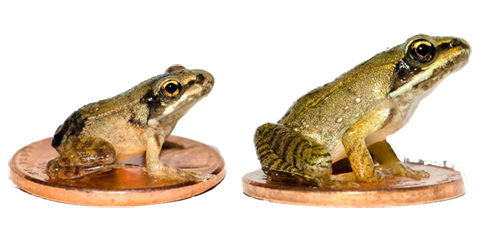
Left: Metamorph from a fast-drying pool. Right: Metamorph from a slow-drying pool. Photo by Kyle Brooks.
Warmer spring weather is bringing the familiar early sounds of spring peepers and wood frogs calling. These amphibians breed in temporary vernal pools, which are small bodies of water that are critical habitat to many amphibians and aquatic invertebrates.
Ohio University researchers have discovered some new things about the life of wood frog tadpoles that might shed light on how climate change and drier conditions affect these amphibians.
They found that tadpoles in faster-drying pools adapted by metamorphosing more quickly. The result was smaller frogs who would never catch up in size to frogs that came from slower-drying pools. But their survival rates as juvenile frogs on land were, surprisingly, very similar, although the petite frogs weren’t able to travel as far or as fast as their full-size counterparts.
“This study sheds light on the future of amphibian populations under future climate conditions, and shows that the sky is not always falling,” says Cassandra Thompson, a Biological Sciences graduate student. “This study also showcases the importance of conserving forests surrounding vernal pools. As juvenile frogs disperse from vernal pools after metamorphosis, they may have difficulties moving through altered forest habitat, which may have warmer and drier conditions.”
Eggs to Tadpoles to Juvenile Frogs to Adult Frogs
“This is the basic life-cycle of a frog that we all learn about in primary school. The metamorphosis of tadpoles to juvenile frogs is a fascinating process, but we had a lot of questions about how environmental changes, like faster pond drying, can exert pressures on frog populations,” says Thompson, PhD researcher in Dr. Viorel Popescu’s Conservation Biology Lab at OHIO.
They set out to determine the effect of hydroperiod length (or the amount of time it takes a pool of water to dry) on the growth and survival of frog tadpoles, and the consequences after they emerge as terrestrial animals. They performed a series of aquatic and land experiments using a common North American frog species that breeds in vernal pools, the wood frog (Rana sylvatica).
“For wood frogs, the rate at which pools dry will force tadpoles to develop as quickly as possible to escape the pool before it dries up completely and they desiccate and die, never making it through metamorphosis. However, developing quickly comes at the cost of being a smaller size frog at metamorphosis,” Thompson says.
So how do small frogs from fast drying pools compare to larger frogs from non-drying pools? Do they have lower survival and fitness? Can they “catch up” with the larger animals later in life? These are questions that had never been answered empirically before this study, recently published in the journal Oecologia.
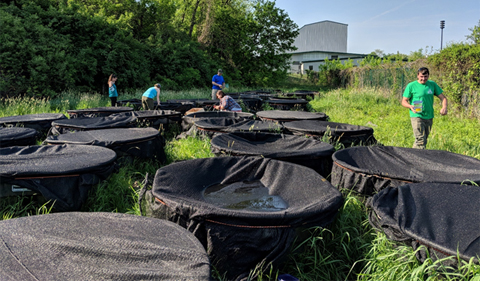
Team of Undergrads & Thompson Collecting Wood Frog Tadpoles for Measurements at the Aquatic Mesocosm Facility. Photo by Viorel Popescu.
Frog Tracking: Cattle Tanks, Terrestrial Pens and Fluorescent Tags
Thompson and a team of Biological Sciences undergraduate researchers raised wood frog tadpoles in 40 300-gallon cattle tanks that were set up as semi-natural environments (or mesocosms) at OHIO’s Aquatic Mesocosm Research Facility.
After adding the tadpoles, they experimentally manipulated the water levels. Some tadpoles experienced fast drying conditions, while others experienced slower drying or no drying conditions. The researchers would capture a small portion of tadpoles from each tank every few weeks to study their development until they metamorphosed into small frogs.
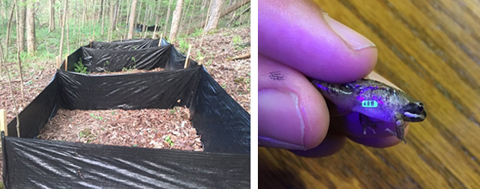
Left: Outdoor terrestrial pens where metamorph frogs from different aquatic treatments were monitored. Right: Metamorph with a unique subdermal tag that fluoresces under UV light. Photo by Cassie Thompson.
So, do faster drying pools make smaller frogs? The answer is yes. Not only do faster drying pools result in smaller sizes at metamorphosis, but they also lead to fewer tadpoles surviving to metamorphosis overall.
But the key question was whether smaller frogs (from faster drying pools) are as capable to survive on land as larger frogs. To answer this, Thompson and colleagues set up 60 2-by-2-meter terrestrial pens in a wooded area, and added eight frogs per pen. Researchers searched the pens every two weeks to catch frogs and take size measurements. Additionally, each frog was tagged with a unique small fluorescent tag to be able to track each frog through time.
Their findings were unexpected. Small frogs from fast-drying pools survived at similar rates as larger frogs from slow drying and non-drying pools. This was surprising and contrary to the mainstream thought that larger frogs are better equipped to survive once they leave the pond. However, smaller frogs (from the faster drying ponds) grew more slowly compared with the larger frogs (from slow drying ponds), and they never caught up in size with the larger animals.
Additionally, smaller frogs from fast-drying ponds may not be able to move as far or fast in their terrestrial habitat. To understand locomotor ability, Thompson ran endurance trials at various temperatures and hydration levels finding that those smaller frogs had lower overall endurance (how fast and far they can travel in a given period) compared with larger frogs from slow-drying pools.
In a nutshell, Thompson and colleagues challenged the conventional wisdom about the effects of aquatic stressors, such as hydroperiod length, on the later life stages of pond-breeding amphibians. Pond-breeding amphibians have a complex toolset of adaptations for coping with faster drying ponds. Fast drying pools resulted in lower tadpole survival and smaller sizes at metamorphosis, but had no effect on terrestrial survival of juvenile frogs.
Amphibians are currently one of the most threatened taxa worldwide with more than a third of global amphibian species being listed by the International Union for the Conservation of Nature as threatened, endangered, or critically endangered. Overall, this research adds to the puzzle of the future of amphibians in the face of climate change.
This work was funded by OHIO Biological Sciences, OHIO’s Program to Aid Career Exploration (PACE), the OHIO Graduate Student Society, and by NSF Graduate Research Fellowship Program. For more information, contact Cassie Thompson (ct824310@ohio.edu) and Viorel Popescu (popescu@ohio.edu).
Citation: Thompson, C. M., & Popescu, V. D. (2021). Complex hydroperiod induced carryover responses for survival, growth, and endurance of a pond-breeding amphibian. Oecologia, 1-11. (https://link.springer.com/article/10.1007/s00442-021-04881-3)


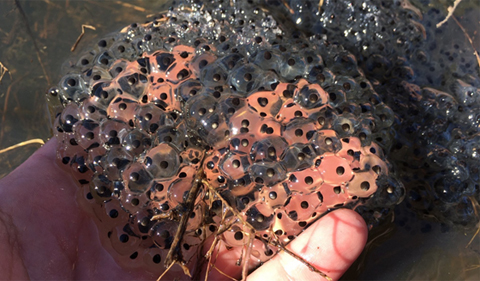
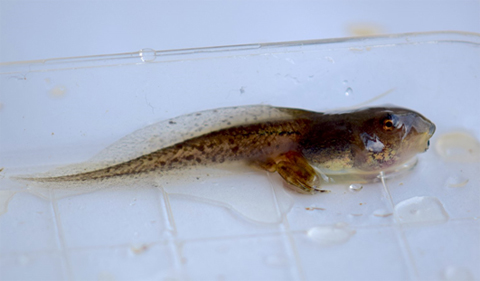
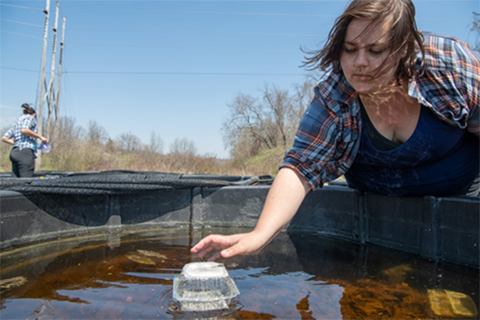
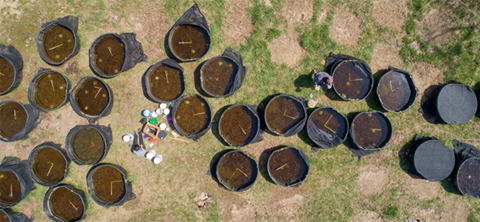

















Comments